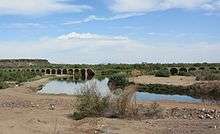Gillespie Dam
| Gillespie Dam | |
|---|---|
 The Gila River flows freely through the breached dam. | |
| Official name | Gillespie Dam |
| Location | Maricopa County, Arizona, USA |
| Opening date | 1921[1] |
| Dam and spillways | |
| Impounds | Gila River |
| Height | 80 feet (24 m) |
| Length | 1,700 feet (520 m) |
| Reservoir | |
| Creates | Gillespie Dam Reservoir (former) |
The Gillespie Dam is a concrete gravity dam located on the Gila River between the towns of Buckeye and Gila Bend, Arizona. The dam was constructed during the 1920s for primarily irrigation purposes. A portion of the dam failed unexpectedly in 1993 during unusually heavy rains.
History
The Gillespie Dam was constructed circa 1920 by a local rancher, Frank Gillespie, to replace an existing structure.[2][3] As the dam was located at an important river crossing that would later become US Route 80, the Arizona Highway Department - the predecessor to the Arizona Department of Transportation - constructed a concrete apron at the foot of the dam to allow for vehicular crossings. As the dam was a simple spillover construction, during times of heavy runoff cars would have to be pulled through the flow by trucks, and during floods could not cross at all.[1]
In anticipation of the formation of the United States Highway System in 1926, the Highway Department commissioned the construction of a steel truss bridge just downstream from the dam. The bridge was completed and opened to traffic on August 1, 1927 at a cost of US$320,000 (US$3,950,000 in 2007). The bridge, which was at the time the longest highway bridge in the state of Arizona, was immediately incorporated into the highway system as Route 80.[1] The bridge carried US 80 traffic until 1956 when the highway was decommissioned, devolving to a county highway, thus placing the bridge under Maricopa County care. The bridge was added to the National Register of Historic Places on May 5, 1981.[4]
Failure
The winter months of 1993 saw unusually high rainfall amounts that resulted in record flows through central Arizona rivers and streams, including the Salt River, a major tributary to the Gila upstream from the Gillespie Dam.[5] At approximately 10:30 on the morning of January 9, the dam failed when a segment approximately 120 feet (37 m) in length collapsed into the river. While the precise cause of the failure is unknown, the extreme flooding was almost certainly a contributing factor. The precise size of the flood was not recorded due to equipment failure, but an estimate based upon a high-water mark recorded on USGS equipment yielded a peak flow of approximately 200,000 cubic feet (5,700 m3) per second, corresponding to a predicted 65-year flood, or a flood of a magnitude anticipated only once per 65 years. The previous high, recorded during similarly disastrous floods in 1980, had been 178,000 cubic feet (5,000 m3) per second.[6]
Due to the failure, three underground natural gas lines were exposed and later severed by the floodwaters. The bridge downstream survived, and was deemed safe for travel.[1]
The remnants of the dam remain in place and the area is largely accessible to the public. A small earthen embankment exists to divert water into nearby canals.
References
- 1 2 3 4 "Historic Gillespie Dam". Town of Gila Bend. Retrieved 2008-06-03.
- ↑ "Field Excursion Reports". United Nations University. Retrieved 2008-06-03.
- ↑ "Feature Detail Report for: Gillespie". Geographic Names Information System. United States Geological Survey.
- ↑ "Gillespie Dam Bridge". Arizona State Parks. Archived from the original on May 26, 2006. Retrieved 2008-06-03.
- ↑ "Arizona's Most Notable Storms". National Weather Service. Retrieved 2008-06-03.
- ↑ Larson, Robert; James Slosson (1997). Storm-induced Geologic Hazards: Case Histories from the 1992-1993 Winter. Geological Society of America. pp. 32–33.
Coordinates: 33°13′45″N 112°46′10″W / 33.22917°N 112.76944°W